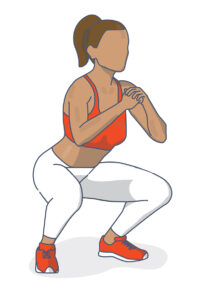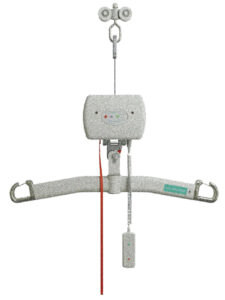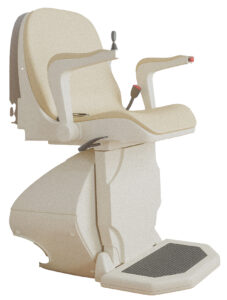![iStock-1395116319 [Converted] Illustration of a woman sitting in a wheelchair and a woman standing behind her with her hands on the push handles.](https://mdaquest.org/wp-content/uploads/2025/11/CARE-Hero-iStock-1395116319-e1762972296226-1024x512.jpg)
7 Essential Tips for Family Caregivers to Avoid Common Injuries
By Megan Kramer-Salvitti | Friday, November 14, 2025
5 Second Summary
Caregiving is rewarding but physically and emotionally demanding. It’s okay — and important — to take steps to prevent injury and care for your own well-being.
According to a joint report by AARP and the National Alliance for Caregiving (NAC), there are more than 60 million family caregivers in the United States, meaning roughly 1 in 4 American adults is a caregiver to an adult or child in their lives with an illness or disability.

Areti Vassilopoulos, PhD
While being a caregiver is one of the most meaningful roles you can take on for your family member, it does come with challenges and risks to your own health.
Caregiving is physically demanding — lifting, transferring, bending, reaching — as well as emotionally and mentally taxing. Many caregivers experience injuries. They may also feel stress, anxiety, depression, or fatigue, says Areti Vassilopoulos, PhD, a pediatric health psychologist and assistant professor at the Yale School of Medicine.
Fortunately, most injuries are preventable with the right knowledge, habits, and tools, and there is support available for mental health needs.
Here are some practical tips to help you give care with confidence — and take care of yourself.
1. Know the most common caregiver injuries

Angela Escalante
Before you can truly prevent an injury, it’s helpful to understand what parts of your body are most at risk and why. Common caregiver injuries include:
- Back strains and sprains
- Shoulder and neck pain
- Wrist and hand injuries
- Knee pain
Most of these injuries result from repetitive strain, improper body mechanics, or lack of muscle support, according to Angela Escalante, an occupational therapist at the Barrow Neurological Institute. That’s why prevention involves more than just being careful — it’s also about building strength, using the right techniques, and employing assistive devices.
2. Master body mechanics
How you move your body matters. Angela recommends educating yourself on techniques for lifting and transferring, including:
- Bend your knees, not your back. Always lift using the muscles in your legs, keeping your back straight and your core engaged.
- Keep the person close to your body. The farther away their weight is, the more strain it places on your spine.
- Avoid twisting. Turn your whole body with your feet instead of rotating your torso.
- Use a wide stance. This helps distribute weight evenly to keep your balance.
- Ask for help or use assistive equipment. Don’t risk injury trying to do a difficult lift alone.
It’s always important to think about these techniques. It can be difficult to take the time to position yourself correctly when you’re in a hurry or feeling stressed, but doing so can prevent pain and injury, which is better for you and your loved one in the long run.
“When caregivers take care of their own bodies and protect themselves from injury, they are able to give their best care to their loved ones,” Angela says.
3. Strengthen your body
Doing a handful of simple exercises consistently can help strengthen and protect your muscles and joints from injury. Here are some exercises you can do at home, with little to no equipment.
Core strengthening
Your core (which consists of your abs and back) is your powerhouse — it stabilizes your body when lifting and moving and protects your back. Engage your core muscles by drawing your belly button in toward your spine. To strengthen your core, do one or more of these exercises:

Starting position for supine march and leg extensions
- Supine march. Lie on your back with your knees bent. Raise one foot off the ground at a time.
- Supine leg extension. Lie on your back with your knees bent. Straighten one knee and hold your leg a few inches off the ground. Bring it back to the starting position and repeat with your other leg.
- Plank. Begin on all fours with your arms directly under your shoulders. Extend your legs behind you and hold the position with your back straight.
- Bridge. Lie on your back with your knees bent. Raise your hips off the ground and lift your chest, keeping your core tight and head relaxed on the ground.
Back and shoulder strengthening
These are your primary lifting muscles. Try these exercises to strengthen your back and shoulders:
- Seated rows with dumbbells. Sit with a light- to medium-weight dumbbell in each hand. Lean your torso forward, keeping your back straight, and let your arms hang toward the floor. Pull the dumbbells up, bending your elbows and squeezing your shoulder blades together.
- Shoulder blade rolls/squeezes. Sit up straight and gently squeeze your shoulder blades together. Pause, then relax.
- Shoulder external rotations with a resistance band. Stand with your elbows bent to 90 degrees and your palms up, holding a resistance band in both hands. Slowly rotate your forearms out to the sides while pinching your shoulder blades together. Pause, then return to the starting position.
Leg strengthening
Using your legs for heavy lifting protects your back. These exercises strengthen the leg and glute muscles:

Squat position
- Squats or mini squats. Stand with your feet shoulder-width apart and your toes pointing forward. Keeping your back straight, bend your knees, lowering until they are at a 90-degree angle, then return to the starting position. For mini squats, rest your hands on a stable surface, such as a counter, and do not bend down as deeply.
- Clamshells. Lie on your side with your knees bent and hips stacked. Lift your top knee, keeping your feet together. Repeat on both sides.
Wrists and hands
Repetitive strain and poor positioning can lead to wrist and hand pain. To protect your wrists, keep them straight while completing tasks, and do these exercises to stretch and strengthen the muscles and connective tissues:
- Wrist circles. Start with your hands in loose fists. Circle your fists in one direction, then the other.
- Wrist stretches. Hold one arm out straight at shoulder height and bend your wrist backward so your fingers point up. Use the other hand to gently pull the fingers back until you feel a stretch in the forearm. Let go and bend the wrist forward so the fingers point down. Use the other hand to gently push on the back of the hand until you feel a stretch in the top of the arm. Switch arms and repeat.

Wrist stretches
- Hand stretch. Make a fist and hold it for a few seconds. Open your fist and spread your fingers as far apart as you can. Repeat with the other hand.
Listen to your body
Pay attention to how your body feels while exercising and performing caregiving tasks. If you feel sudden, sharp pain, ongoing soreness that doesn’t improve, or numbness, weakness, or tingling in your limbs, speak with a healthcare provider immediately.
Early treatment can prevent a small issue from becoming a long-term problem.
4. Use the right tools
Assistive equipment can decrease your chance of injury by supporting the weight of moving and transferring your loved one and enhancing their own mobility.
Here are some products that can help.
Transfer aids
- Gait belt. Goes around the waist of the person being assisted to give the caregiver a secure hold to help steady or move them

Product credit: Vive Gait Belt
- Transfer board or slide board. Helps move someone in a sitting position, such as from a bed to a wheelchair

Product credit: DMI Transfer Board
- Transfer sheets. Reduce friction and help reposition someone in bed safely

Product credit: Vive transfer sheet
- Floor lift (often called a Hoyer lift). Portable lift that can help pick up and move a person from a bed, toilet, bathtub, shower, or wheelchair

Product credit: Bestcare floor lift
- Ceiling lift. Motorized lift that moves on built-in rails on the ceiling; often installed in bedrooms and bathrooms

Product credit: Mackworth ceiling lift
Mobility support
- Bed rails and grab bars. Help prevent falls and increase independence for people with mobility issues

Product credit: HealthCraft bed rail
- Stair lift. Motorized seat that transports a person up and down stairs safely

Stair lift
Ergonomic tools
- Raised toilet seats. Make transferring or standing up from sitting easier, minimizing the need for lifting during bathroom visits

Raised toilet seat
- Shower chairs and transfer benches. Allow for safe, seated bathing

Product credit: AquaSense shower chair.
- Standing desk and anti-fatigue mats. Reduce strain on caregivers’ joints while doing paperwork, cooking, and other tasks

Anti-fatigue mat
5. Take care of yourself
Injury prevention isn’t just physical — it’s mental and emotional, too. When you’re exhausted or overwhelmed, you’re more likely to move incorrectly, rush, or ignore warning signs from your body. You are also more vulnerable to stress and fatigue when you don’t take care of your mental health.
Here are some tips for caring for yourself:
- Don’t try to do it all alone. Ask family members or close friends for help or, if possible, hire part-time or respite care. “Surround yourself with your village,” Dr. Vassilopoulos says. “This can include loved ones, but if you do not live near them, consider leaning into your medical team, as well as local and national organizations with resources. I recommend doing this long before you think you need to, because if you wait, it will feel harder.”
- Learn to say no. It may not be easy to say no to your loved one, but if you’re already feeling stressed, it’s OK to decline an extra task or something nonurgent that you don’t feel up to doing.
- Stay hydrated, eat well, and rest when you can. Your body needs fuel and recovery to keep going. “If you follow a schedule, consider blocking off time for yourself,” Dr. Vassilopoulos says. “These do not need to be large chunks of time — even 15-minute blocks sprinkled throughout your day can make it easier to breathe.”
- Seek therapy as early as possible. “Try not to wait until a mental health crisis happens,” says Hillary Cohen, LICSW, a clinical social worker in the Department of Neurology at MedStar Georgetown University Hospital. “Therapy can teach you techniques to cope if or when a crisis does happen.”

Hillary Cohen, LICSW
- Acknowledge your feelings. Hillary says it’s important to know that your feelings are valid and be open about them with your friends and family, as well as your therapist, so they know how they can support you. “Caregivers may not always be fully honest in how they’re feeling because there is a stigma around this,” she says. “Try not to judge yourself for how you’re feeling. It’s normal to hold many, seemingly conflicting feelings at once.”
- Take care of your physical health. “Do not neglect your annual primary care visits, vaccinations, dentist appointments, and eye care,” Dr. Vassilopoulos says. “Feeling physically better will help you feel mentally better and support your caregiving efforts.”
- Remember, caring for someone doesn’t mean neglecting yourself. Learn how caregivers in our community practice self-care in their own lives.
6. Communicate with your loved one
Communicating openly and honestly is necessary for any relationship to thrive. Effective communication between caregivers and loved ones can limit misunderstandings and accidents and help with decision-making, which reduces overall stress and frustration for everyone.
Here are some communication tips:
- Approach conversations with empathy. Try to understand your loved one’s point of view before jumping to conclusions or making accusations.
- Remain respectful. When you’re frustrated, it can be easy to lash out in the moment. But expressing yourself clearly and respectfully will lead to better outcomes in the long run.
- Prepare your thoughts. If it’s difficult to address a tough topic, try writing down what you’re feeling and what you’d like to say before you approach your loved one.
- Practice active listening. Listening is the other side of the communication coin. Make sure you’re fully present in conversations and are listening with the intent to understand, not just to respond. Try to pick up on nonverbal cues and repeat what your loved one said back to them to ensure you’re on the same page.
If you have help from other caregivers or support systems, practice these tips with them, as well.
7. Use your resources
Hillary and Dr. Vassilopoulos both recommend seeking resources for caregivers, including support groups where you can connect with others in similar situations. Check out MDA’s list of caregiver resources.
“You’re not alone,” Hillary says. “There are so many people in caregiving roles. We all struggle at times, and this is really normal. It’s okay — and important — to take care of yourself and get help.”
Megan Kramer-Salvitti is a writer for Quest Media.
Next Steps and Useful Resources
- Download MDA’s Guide for Caregivers for information, tips, and resources for caregivers.
- Watch the MDA Virtual Learning webinar Caring for the Caregiver.
- MDA’s comprehensive online Caregivers Seminar includes segments on communication, balancing self-care with caregiving, and financial planning.
- Everyone needs a fun break. MDA’s Family Getaways provide a unique recreation experience for individuals living with neuromuscular disease and their families.
- Stay up to date on Quest content! Subscribe to Quest Magazine and Newsletter.
TAGS: Caregiving, Equipment and Assistive Devices, Featured Content, Relationships, Resources
TYPE: Featured Article
Disclaimer: No content on this site should ever be used as a substitute for direct medical advice from your doctor or other qualified clinician.




